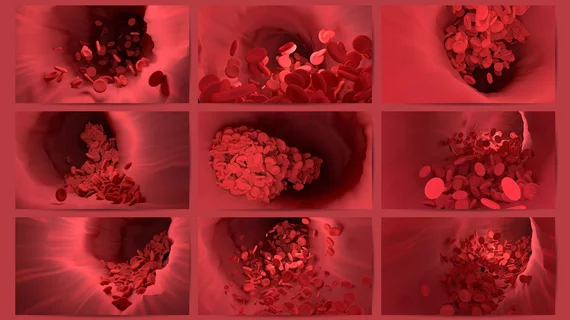Imaging shows COVID vaccines effective at warding off pulmonary embolism
Examining the prevalence of pulmonary embolism (PE) in COVID-infected patients in a single ER across three peaks in the pandemic, researchers have found the condition significantly less among patients who received at least two doses of a COVID-19 vaccine.
The patients were seen at the University of Utah Hospital during the ancestral wave (Nov. 15 to Dec. 29, 2020), Delta wave (Aug. 10 to Sep. 23, 2021) and Omicron wave (Jan. 1 to Feb. 18, 2022). Together these peaks totaled around 25,300 patients.
Lead author Nicole Law, MD, senior author Dell Dunn, MD, and colleagues focused on the patients who were imaged with computed tomography pulmonary angiography (CTPA) as deployed to find or rule out PEs.
The team considered demographic information, patient comorbidities and risk factors, vaccination status, and COVID-19 infection status as documented in patients’ charts, then split the three cohorts into subgroups to look for effects of vaccination on PE occurrence.
Their key findings as published this month in Emergency Radiology:
- CTPA was ordered in 18.3% of COVID-positive patients during the ancestral variant period, 18.3% during the Delta period and 17.3% during the Omicron wave.
- PE was seen in 15.0% of the ancestral COVID variant cohort, 10.6% in the Delta COVID cohort and 9.23% of the Omicron cohort, reflecting a 41% and 60% increased risk of PE with ancestral variants compared to Delta and Omicron periods, respectively.
- The study, however, “was underpowered and the difference in rate of PE did not reach statistically significance (p = 0.43 and p = 0.22),” the authors report.
- Unvaccinated patients had a 2.75-fold increased risk of COVID-associated PE during the Delta and Omicron periods (p = .02) compared to vaccinated or recovered patients.
“Vaccination reduces the risk of COVID-19 associated PE,” the authors conclude. “Patients infected with the Delta and Omicron COVID-19 variants may have a lower incidence of pulmonary embolism, though a larger or multi-institution study is needed to prove definitively.”
In their discussion, Law et al. acknowledge that PE detection may depend largely on the perspective of the emergency-med provider ordering the CTPA exam. Moreover, “using total emergency COVID-19 diagnoses is a crude method to control for changes in ordering habits that may have occurred over these different time periods of the COVID-19 pandemic.”
More:
Though our findings do not reach statistical significance, they suggest that patients infected with the Delta or Omicron COVID-19 variants may have a lower incidence of pulmonary embolism. Vaccination with at least two doses does significantly reduce the risk of COVID-19 associated PE.”
The study is available in full for free.
More content on CT pulmonary angiography:
Providers blunt skyrocketing use of CT for pulmonary embolism, but numbers still climbing
Time-of-day CT demand data provide low-cost method to improve radiology resource planning, quality
Targeting a new quality challenge in radiology: CT repeat rates within the same examination
Reference:
Nicole Law, Jessica Chan, Christopher Kelly, William F. Auffermann and Dell P. Dunn, “Incidence of pulmonary embolism in COVID-19 infection in the ED: ancestral, Delta, Omicron variants and vaccines.” Emergency Radiology, April 21, 2022. DOI: https://doi.org/10.1007/s10140-022-02039-z

